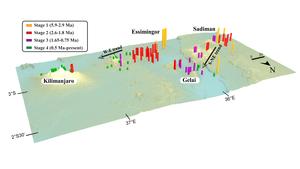25 Giugno 2019 - BREAKING APART: the influence of magmatism in continental rifting - Dr. Sara Mana (Salem State University, USA)

Seminari di geologia
Mercoledi 25 giugno 2019 alle ore 15.00 si svolgerà in aula Ruffini il seminario dal titolo:
BREAKING APART:
the influence of magmatism in continental rifting.
Dr. Sara Mana
Department of Geological Sciences at Salem State University, USA
In the East African Rift (EAR), rifting and associated volcanism have been modeled as the onset of one or more magma plumes producing pre-rift magmatism and weakening the lithosphere into the generation of an active rifting. The plume hypothesis is supported by seismic data, which brought to the identification of a large-scale low velocity province called the African Superplume focused under the EAR across the entire mantle, which has been modeled as a thermo-chemical structure. Nevertheless, the details of how an active rifting is triggered are not well understood. My study aims at better understanding the initial stage of rifting.
The North Tanzanian Divergence (NTD) zone represents an example of an early stage continental rifting where lithospheric melts are generated during the interaction of a mantle plume and a heterogeneous metasomatized lithosphere. In this area magmatism started at ~5.8Ma in a pre-rift environment and continued until recent days with the activity of Oldoynio Lengai. NTD magmatism is chemically heterogeneous; a diverse array of magmas from basalt to rhyolite, trachyte, phonolite and carbonatite occur at various volcanic centers, some of which have erupted more than one magma type. We provide new 40Ar/39Ar ages, geochemical and radiogenic isotopic analyses on samples of lava collected from several volcanoes distributed across the NTD. Data obtained on these samples set the basis for the interpretation of the origin and evolution of NTD magmatism and its relationships to fault initiation and subsequent propagation. Based on our tectono-magmatic reconstruction melting occurs in the garnet stability zone. The first melt produced derives from fusible amphibole rich veins. Through the NTD rifting development, melting conditions change to generate alkali basalts with systematically different isotopic signatures. This episode of magmatism consists of an intense pulse, related to the inception of rifting, and characterized by melt separation occurring at shallower depths. The observed chemical signature can be explained either with the involvement of contributions from plume related fluids, or by melting of layered lithosphere. Subsequent volcanism has features consistent with mixing between the first two events. Through time we observe an eastwards migration of the magmatic activity consistent with the hypothesis of a fixed mantle plume and an overall westward migration of the African plate.
Building on this experience I am now looking at the Turkana Basin, a unique intra-domal region of the EAR where evidence for the earliest phases of both magmatism and extension co-occur. In this region magmatism has been persistent since ~36Ma (to K-Ar ages on the Lokitaung basalts) till today (Central island) giving us the opportunity to track magma evolution throughout the history of the basin.





